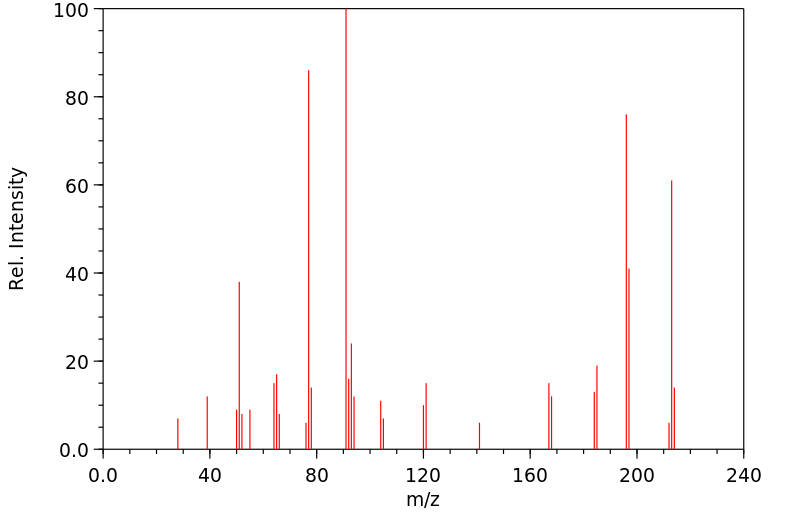(6E)-6-[(N-hydroxyanilino)methylidene]cyclohexa-2,4-dien-1-one | 20357-59-9
中文名称
——
中文别名
——
英文名称
(6E)-6-[(N-hydroxyanilino)methylidene]cyclohexa-2,4-dien-1-one
英文别名
N-(salicylidene)aniline N-oxide;α-(2-hydroxyphenyl)-N-phenylnitrone;N-(2-hydroxybenzylidene)aniline oxide;C-(2-hydroxyphenyl)-N-phenyl-nitrone;C-(2-hydroxyphenyl)-N-phenylnitrone;N-(salicylidene)phenylamine-N-oxide;salicylaldehyde-(N-phenyl oxime )
CAS
20357-59-9;97971-52-3
化学式
C13H11NO2
mdl
——
分子量
213.236
InChiKey
ORXOGPXBVINWDG-UHFFFAOYSA-N
BEILSTEIN
——
EINECS
——
-
物化性质
-
计算性质
-
ADMET
-
安全信息
-
SDS
-
制备方法与用途
-
上下游信息
-
文献信息
-
表征谱图
-
同类化合物
-
相关功能分类
-
相关结构分类
计算性质
-
辛醇/水分配系数(LogP):2.65
-
重原子数:16.0
-
可旋转键数:2.0
-
环数:2.0
-
sp3杂化的碳原子比例:0.0
-
拓扑面积:46.3
-
氢给体数:1.0
-
氢受体数:2.0
SDS
上下游信息
-
下游产品
中文名称 英文名称 CAS号 化学式 分子量 亚水杨基苯胺 N-phenylsalicylaldimine 779-84-0 C13H11NO 197.236
反应信息
-
作为反应物:描述:(6E)-6-[(N-hydroxyanilino)methylidene]cyclohexa-2,4-dien-1-one 在 劳森试剂 作用下, 以 苯 为溶剂, 反应 0.5h, 以47%的产率得到亚水杨基苯胺参考文献:名称:Jorgensen, K. A.; Shabana, R.; Scheibye, S., Bulletin des Societes Chimiques Belges, 1980, vol. 89, # 3, p. 247 - 254摘要:DOI:
-
作为产物:参考文献:名称:新型2,3,5-三芳基-4 H,2,3,3a,5,6,6a-六氢吡咯并[3,4- d ]异恶唑-4,6-二酮的合成和评价对晚期糖化终产物形成的抑制作用活动摘要:通过取代的甲亚胺N-氧化物1与取代的N-芳基马来酰亚胺2的1,3-偶极环加成反应,导致形成新的立体异构体2,3,5-三芳基-,完成了一些生物学上有趣的吡咯并-异恶唑烷衍生物的合成。4 H,2,3,3a,5,6,6a-六氢吡咯并[3,4- d ]异恶唑-4,6-二酮衍生物3高产。根据合成的化合物在牛血清白蛋白(BSA)-葡萄糖测定中抑制AGEs形成的能力,对它们的高级糖基化末端(AGE)产物形成抑制活性进行了筛选。已经发现所有合成的化合物均显示出显着的抗AGE形成活性。DOI:10.1016/j.bmcl.2012.11.080
文献信息
-
Rapid, efficient, and room temperature synthesis of nitrones in excellent yields over MgO under solvent-free conditions作者:Hassan Valizadeh、Leila DinparastDOI:10.1002/hc.20527日期:——A large variety of C-aryl and C-alkyl nitrones were synthesized within 0.5–15 min via the condensation of aldehydes with N-(methyl, phenyl, or t-butyl)hydroxylamines over MgO by hand-grinding with an agate mortar. These reactions were investigated under different conditions and over different solid supports including basic alumina, montemorillonite, MgO, and molecular sieves (pore size 3 A). In the通过用玛瑙研钵手工研磨,醛与 N-(甲基、苯基或叔丁基)羟胺在 MgO 上缩合,在 0.5-15 分钟内合成了多种 C-芳基和 C-烷基硝酮。这些反应在不同条件下在不同的固体载体上进行研究,包括碱性氧化铝、蒙脱石、MgO 和分子筛(孔径 3A)。在更有趣的情况下,硝酮是在 MgO 上制备的,无需加热和任何催化剂。在此过程中,硝酮的制备时间非常短,收率高,纯度好,而且在后处理中不使用有害溶剂。© 2009 Wiley Periodicals, Inc. 杂原子化学 20:177–181, 2009; 在线发表于 Wiley InterScience (www.interscience.wiley.com)。DOI 10.1002/hc.20527
-
1,3-dipolar cycloaddition reactions of 2-substituted azomethine N-oxides with N-benzyl maleimides leading to the synthesis of stereoisomers作者:Rahul Badru、Sakshi Shah、Baldev SinghDOI:10.1002/jhet.794日期:2012.3The azomethine N‐oxides (1) on reacting with N‐benzylmaleimide (2) provide a mixture of stereoisomers 2,3‐diphenyl‐5‐benzyl‐4H‐2,3,3a,5,6,6a‐hexahydropyrrolo[3,4‐d]isoxazole‐4,6–dione derivatives (3) in good yields. These isomers have been assigned cis and trans configurations (3‐A and 3‐B) with respect to proton C3‐H on the azomethinic carbon on the basis of their PMR and H‐NMR COSY data. The ratio
-
Efficient combination of task-specific ionic liquid and microwave dielectric heating applied to synthesis of a large variety of nitrones作者:Hassan ValizadehDOI:10.1002/hc.20581日期:——Under mild microwave irradiation conditions and without any additional organic solvents, a large variety of nitrones were prepared in a weak Lewis base phosphinite task-specific ionic liquid (TSIL-OPPh2) in excellent yields. This catalytic TSIL was also recyclable. Under optimized microwave irradiation conditions, the reaction occurred at very shorter reaction time and higher yields in comparison with
-
Synthesis and Antimicrobial Evaluation of New Pyrrolo-isoxazolidine Derivatives作者:Mohamad Yusuf、Shehneela、Baldev SinghDOI:10.14233/ajchem.2019.21726日期:——In the present study, pyrrolo-isoxazolidines 3(a-l) and 4(a-e), 4g, 4i, 4j have been synthesized by using the 1,3-dipolar cycloaddition reactions of nitrones 1(a-l) with ester substituted N-aryl maleimide (2b). These heterocycles have been obtained in cis and trans diastereomeric forms. The structures of newly synthesized heterocycles have been confirmed from their spectroscopic parameters such as IR, 1H NMR, 13C NMR and ESI-MS. The in vitro antimicrobial evaluation of these compounds were also investigated. Most of the prepared heterocycles showed significant antimicrobial properties. C3-phenyl substituted products exhibited the remarkable antibacterial behaviours while C3-thienyl/furyl substituted heterocycles proved themselves potent antifungal agents.
-
Mechanisms for the Deactivation of the Electronic Excited States of α-(2-Hydroxyphenyl)-N-phenylnitrone: From Intramolecular Proton and Charge Transfer to Structure Twisting and Aggregation作者:Leonardo Martins Carneiro、Artur Franz Keppler、Fabio Furlan Ferreira、Paula Homem-de-Mello、Fernando Heering BartoloniDOI:10.1021/acs.jpcb.2c03924日期:2022.9.29transition). Potential energy curves (PECs) for the S1 state of Nit–OH did show that there are structures associated with excited-state intramolecular proton transfer (ESIPT), and the existence of an intramolecular H-bonding was confirmed using X-ray powder diffraction (XRD). Twisted intramolecular charge transfer (TICT) took place following ESIPT, and a nonradiative deactivation at the S1/S0 conical intersection寻找新的突出化学传感器与合理化可能的多种激发态失活途径显着相关。我们制备并研究了化合物α-(2-羟基苯基) -N-苯基硝酮(Nit-OH),观察到Nit-OH在紫外-可见光下在乙腈溶液中是稳定的。实验观察到的 Nit-OH 的 540 nm 荧光显示与在 360 nm 处从最高占据分子轨道到最低未占据分子轨道(HOMO-LUMO 跃迁)的激发有关。S 1的势能曲线 (PEC)Nit-OH 的状态确实表明存在与激发态分子内质子转移 (ESIPT) 相关的结构,并且使用 X 射线粉末衍射 (XRD) 证实了分子内氢键的存在。在 ESIPT 之后发生了扭曲的分子内电荷转移 (TICT),并且在 S 1 /S 0锥形交叉处发生了非辐射失活;在 540 nm 处观察到与堆叠二聚体的形成相关的聚集诱导发射。基于荧光激发波长对 Nit-OH 浓度的依赖性,提出了来自 S 2的反 Kasha 发射。根据 S
表征谱图
-
氢谱1HNMR
-
质谱MS
-
碳谱13CNMR
-
红外IR
-
拉曼Raman
-
峰位数据
-
峰位匹配
-
表征信息
同类化合物
(2-氯-6-羟基苯基)硼酸
黄柄曲菌素
高香草酸-d3
高香草酸-13C6
高香草酸
高香兰酸乙酯
高辣椒素II
高二氢辣椒素I
香草醛醛肟
香草醛苯腙
香草醛-甲氧基-13C
香草醛-(N-对甲苯基肟)
香草醛
香草酸肼
香草壬酰胺
香草基扁桃酸乙酯
香草吗啉
香草二乙胺
香兰素胺硬脂酸盐
香兰素胺硬脂酸盐
香兰素胺盐酸盐
香兰素丙二醇缩醛
香兰素13C6
香兰素-D3
香兰基乙基醚
香兰基丁醚
顺式-5-正十五碳-8'-烯基间苯二酚
顺式-1-(2-羟基-5-甲基苯基)-2-丁烯-1-酮
顺式-1-(2-羟基-4-甲氧基苯基)-2-丁烯-1-酮
顺-3-氯二氢-5-苯基呋喃-2(3H)-酮
雌二醇杂质1
降二氢辣椒碱
阿诺洛尔
阿瓦醇
阿普斯特杂质
间苯二酚双(二苯基磷酸酯)
间苯二酚-烯丙醇聚合物
间苯二酚-D6
间苯二酚
间苯三酚甲醛
间苯三酚二水合物
间苯三酚
间羟基苯乙基溴
间硝基苯酚
间甲酚紫钠盐
间甲酚与对甲酚和苯酚甲醛树脂的聚合物
间甲酚-D7
间甲酚-D3
间甲酚
间溴苯酚







